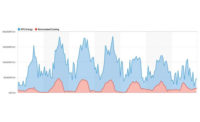The world of building automation is becoming more reliant on the latest technologies, which is changing the perspective on what skill sets are most important for a technician to have. Twenty years ago, technicians were reliant on their strong abilities to understand HVAC fundamentals and troubleshoot wiring. Today, a control technician's fundamentals start at, “How do I connect to the system?” A bag of tools has turned into a computer bag filled with networking cables and a laptop loaded with different virtual private network (VPN) applications and software packages. The simple question of how I connect can sometimes become a complicated journey. This column will examine the skill sets a modern controls candidate must possess that go beyond the basics of HVAC.
Fundamentals of computer networking are an absolute requirement. Three initial questions come to mind: What is a router? What is a switch? What is subnetting?
It has never been OK to define a word using the word itself, but, in the case of a router, it’s better to keep it simple. A router routes packets based on their IP addresses. It connects local networks, called LANs, to larger networks, called WANs, and allows users to share one connection to multiple devices. A router is almost like a highway. When we travel around town, we use our smaller roads and stay local, but when it's time to get away, we generally get on the highway to leave town.
A switch is not as complex, but it helps with the overall efficiency of a network. A switch gives users the ability to connect multiple end devices to the network and also plays a role in forwarding information carefully in the network. A switch is similar to a traffic light. If everyone was to drive through the same intersection, at the same time, a collision would occur. This is similar to networking. Packet collisions slow the network just as an accident slows the flow of traffic.
Subnetting is the process of dividing a network into usable addresses, but understanding it requires a bit more knowledge than simply typing in an IP address. Basic knowledge of subnetting will be the difference between a technician being able to access a controller or needing to call for help, wondering why they cannot connect.
While not a requirement to be effective in building automation, an understanding of web design is more than helpful in a modern system. Everything is web-based today and accessed via a browser. Understanding what constitutes a display issue with a browser versus an actual control system issue can save time and money. Anyone who has dabbled in web design understands the importance of flow when it comes to navigating around a website. Many of us have seen systems where the navigation buttons/links/graphics have seemed to shift around as we navigate the control system. This lack of continuity can lead to the perception of a cheap or unfinished product. Having a person with a web-based skill set will more than likely lead to a creative and well-polished user interface.
All control systems value data. Historical data is used for validating operations, troubleshooting faults, and energy management. Different building automation systems (BASs) rely on different types of databases to store information. Having basic knowledge and understanding of relational databases, such as structured query language (SQL) or MySQL, can go a long way to maintaining an efficient system. Generally speaking, an individual who has dabbled in database queries tends to possess a basic skill set in scripting. Even if they never need to access a database during their career, they still have the qualities of a troubleshooter who is not afraid to dive into the deeper parts of a system.
The most important trait, by far, is curiosity. Today's systems can be built, controlled, and managed in thousands of different ways. Curiosity helps us continue to tune our products into the best systems and is a sign of a well-rounded technician. Reading up on the latest technology, sharing knowledge among peers, and reevaluating what could be done more efficiently is a key indicator of success. Combining unlike skill sets in the workforce can make great pairings. Pairing a person with a deep mechanical background with a person who has a strong computer background can develop two individuals equally.
James Regan has been working in the building automation industry since 2013. He started as a controls technician for Johnson Controls, working primarily in critical hospital environments. He moved on to an energy engineering role optimizing the automation systems of hospitals with a major focus on maintaining proper air quality settings as efficiently as possible. In 2018, he accepted a role as building systems analyst with Piedmont Service Group. In this role, he supported efforts to increase efficiency through identifying poor sequences, faulty field devices, or failing mechanical equipment. He currently is the analytics manager overseeing the building analytics platform where he supports Piedmont Service Group and CMS Controls with optimizing or continuous commissioning through analytics.





